1. The equation of the curve satisfying the
differential equation \[y_{2}\left(x^{2}+1\right)=2xy_{1}\] passing through
The point (0,1 ) and having slope of tangent at x = 0 as 3 is
a) \[y = x^{2} + 3x + 2\]
b) \[y^{2} = x^{2} + 3x + 1\]
c) \[y = x^{3} + 3x + 1\]
d) \[y = x^{2} + 3x + 1\]
Explanation: The given differential equation can be written as y2/y1 = 2x/(x2 + 1). Integrating both the sides we have

2. If log (dy/dx) = 3x + 4y, y(0) = 0 then
y(–log 2) is equal to
a) \[\frac{1}{4}\log\frac{13}{6}\]
b) \[\frac{1}{2}\log\frac{13}{6}\]
c) \[\frac{-1}{4}\log\frac{17}{4}\]
d) \[\frac{-1}{4}\log\frac{13}{6}\]
Explanation:

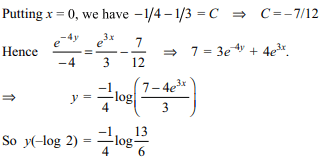
3. For a differential function \[\phi\] with \[\phi\left(1\right)=2\] , the solution of the differential equation \[y'=\frac{y}{x}+\frac{\phi\left(y/x\right)}{\phi'\left(y/x\right)},y\left(2\right)=2\]
is
a) \[x\phi\left(y/x\right)=1\]
b) \[\phi\left(y/x\right)=x\]
c) \[y\phi\left(y/x\right)=2\]
d) \[\phi\left(y/x\right)=y\]
Explanation:

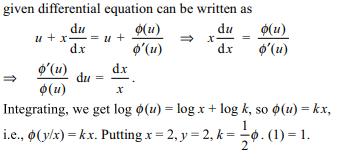
4. The solution of the equation
\[y' – Ay = – By^{2} \left(A ,B > 0\right)\]
is
a) \[y=\left(\left(B/A\right)e^{Ax}+C\right)^{-1}\]
b) \[y=\left(B/A\right)+Ce^{-Ax}\]
c) \[y=e^{-Ax}\left(\left(B/A\right)e^{Ax}+C\right)^{-1}\]
d) \[y=e^{Ax}\left(\left(B/A\right)e^{Ax}+C\right)^{-1}\]
Explanation: The given equation can be written as
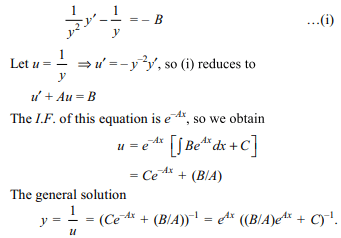
5. The solution of the equation \[dy/dx=\cos\left(x-y\right),y\left(\frac{3\pi}{2}\right)=\pi\]
is
a) \[y+\cot\left(\frac{x-y}{2}\right)=1\]
b) \[x+\cot\left(\frac{x-y}{2}\right)=1+\frac{3\pi}{2}\]
c) \[x+\tan\left(\frac{x-y}{2}\right)=1-\frac{3\pi}{2}\]
d) \[y+\cot\left(\frac{x-y}{2}\right)=1+\frac{\pi}{2}\]
Explanation: Putting u = x – y, we get du/dx = 1 – dy/dx
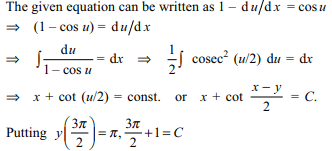
6. Which of the following transformation
reduce the differential equation \[\frac{dz}{dx}+\frac{z}{x}\log z=z\left(\log z\right)^{2}\] f (x) into a linear form
a) u = log z
b) \[u=e^{z}\]
c) \[u = (log z)^{-1}\]
d) \[u = (log z)^{2}\]
Explanation: Dividing the given equation by z(log z)2,

7. Through any point (x y) of a curve which passed through the origin , lines are drawn parallel
to the coordiante axes . The curve , given that it divides the
rectangle formed by the two lines and the axes into two areas , one of which is twice the other, represents a family of
a) circles
b) parabolas
c) hyperbolas
d) straight lines
Explanation: Let P(x,y) be the point on the curve passing through the origin O(0,0), and let PN and PM be the lines parallel to the x- and y axes respectively. If the equation of the curve is y = y(x), the area POM equals
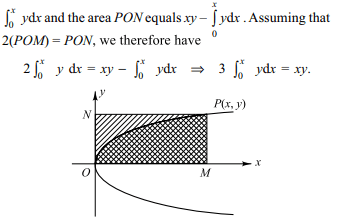


8. The solution of
( y + x + 5)dy = ( y – x + 1) dx is
a) \[\log\left(\left(y+3\right)^{2}+\left(x+2\right)^{2}\right)+\tan^{-1}\frac{y+3}{x+2}=C\]
b) \[\log\left(\left(y+3\right)^{2}+\left(x-2\right)^{2}\right)+\tan^{-1}\frac{y-3}{x-2}=C\]
c) \[\log\left(\left(y+3\right)^{2}+\left(x+2\right)^{2}\right)+2\tan^{-1}\frac{y-3}{x-2}=C\]
d) \[\log\left(\left(y+3\right)^{2}+\left(x+2\right)^{2}\right)-2\tan^{-1}\frac{y+3}{x+2}=C\]
Explanation: The intersection of y - x + 1 = 0 and y + x

9. General solution of the differential equation
\[y=x\frac{dy}{dx}+\frac{dx}{dy}\] represent
a) a straight line or a hyperbola
b) a straight line or a parabola
c) a parabola or a hyperbola
d) circles
Explanation:



10. If for the differential equation \[y'=\frac{y}{x}+\phi\left(\frac{x}{y}\right)\]
the general solution is \[y=\frac{x}{\log \mid Cx\mid}\] then \[ \phi(x/y)\] is given by
a) \[-x^{2}/y^{2}\]
b) \[y^{2}/x^{2}\]
c) \[x^{2}/y^{2}\]
d) \[-y^{2}/x^{2}\]
Explanation:

